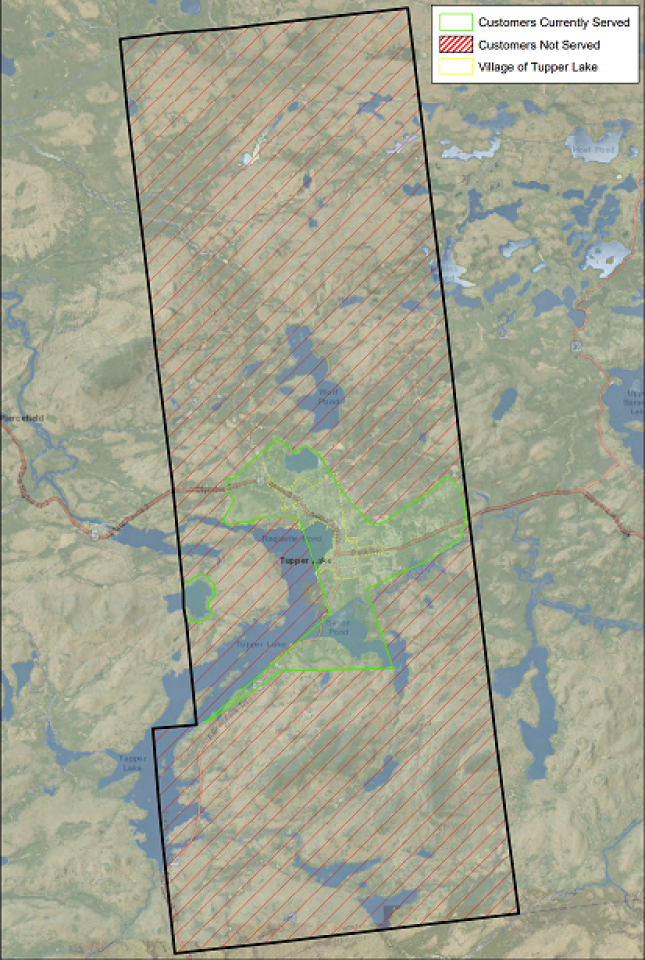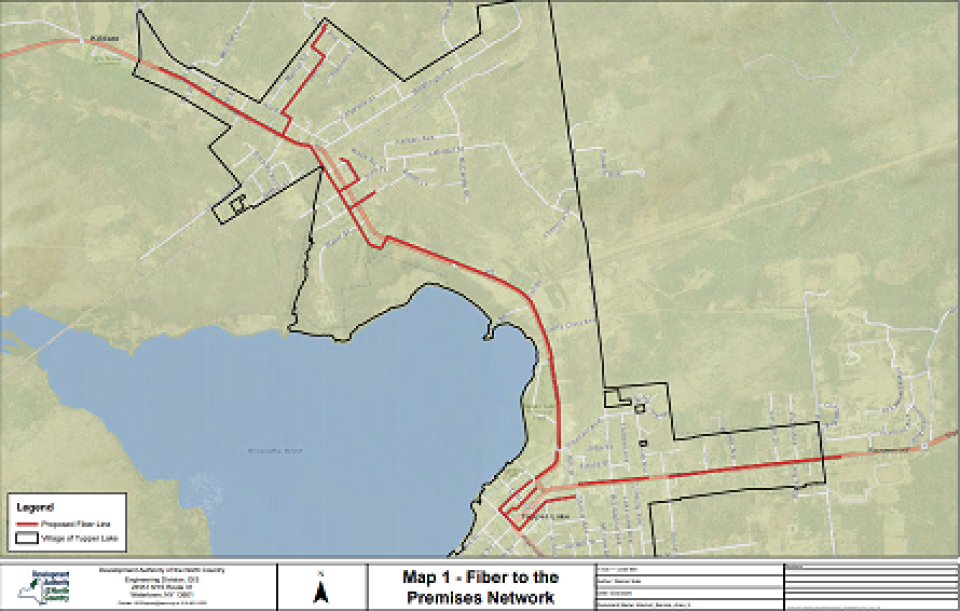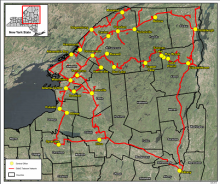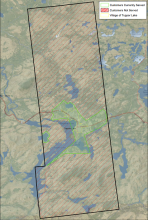
Residents in the village of Tupper Lake, New York, will soon enjoy a municipally owned broadband option to get online. With the awarding of a grant by the Northern Border Regional Commission matched by local funds, a hybrid Fiber-to-the-Home (FTTH) and fixed wireless network will bring faster speeds and more reliable service to homes and businesses in the northern part of the Empire State by the middle of next summer.
Unreliable Service

The village of Tupper Lake (which sits within the boundaries of the town of Tupper Lake) is located in the foothills of the Adirondack Mountains not too far from Lake Placid. It’s an overwhelmingly rural area, and a little more than 3,500 people call the village home.
Last year we wrote about local efforts to improve connectivity options. Back in 2018, a broadband committee was born mostly in response to a lack of Internet access options and complaints about poor service (Spectrum services the region). A study followed that work in 2019, and included a survey of the speeds and prices that homes and businesses in the downtown were paying. Frequent and prolonged outages were a particular problem in Tupper Lake. “We were talking to one business owner who said I was out of service for a day and a half,” Development Authority of the North Country (DANC) General Manager for Telecommunications told WAMC public radio, “[T]hat is almost impossible to do, because now I’ve got to write down credit card numbers and wait for a day to charge people and stuff like that and it just was very difficult.” The Adirondack Daily Enterprise reported that “broadband was the topic of around 30-50% of the emails and calls” to State Assemblyman Billy Jones’ office even before the pandemic.
Connectivity for students was also a driving factor, with a large majority of families with students reporting to the St. Lawrence County school district that they didn't have Internet access at home because they couldn't afford it.
To remedy this and in pursuit of the grant opportunity, Tupper Lake partnered with the DANC, which sent workers to drive every road in the town and document where services were. The village committed to acting as the service provider (though it might contract for it), relying on the DANC’s technical expertise to build the new infrastructure and use its existing fiber for backhaul. With the use of a $200,000 grant and $50,000 in matching funds, the village and DANC will extend the latter’s fiber network to all businesses in Tupper Lake and leverage those assets to stand up antennas to bring wireless service to 125 unconnected homes.
A Hybrid Approach
The DANC was established in 1985 as a public benefit corporation, initially to support operations at Fort Drum. Today, it runs a landfill for three counties, a wastewater division, and operates a regional water line in addition to an open access fiber network around 1,800 miles long. Called the Open Access Telecom Network (see map below), it was begun in 2003 and today serves a host of business and institutional partners in upstate New York. This includes two large medical networks consisting of around 100 facilities (including in Tupper Lake), almost every school in the North Country, most of the municipal services, and other businesses.

Leveraging these assets is key for the Tupper Lake project, David Wolf said in an interview. In addition to the reliability and affordability problems, more than a hundred homes in the community are completely unserved (representing about 5%), and situated mostly outside of the village proper. The $200,00 grant will be supplemented by around $35,000 in cash from the DANC with the town chipping $20,000 in in-kind contributions in the form of office and antenna space. This will pay for roughly 5.5 miles of new 288-strand fiber where needed, as well as the antennas, a router, and software to manage the firewall and user base. The plan is to build a Fiber-to-the-Premises (FTTP) network for all 40 businesses in the downtown area, and then use that infrastructure to erect four towers and provide those 125 unserved homes with wireless. Some homes along the new route will have fiber connectivity right away (and project leaders plan to expand it in the future). A small portion of the funds will be dedicated to adding capacity in existing DANC conduit.
The wireless coverage will connect around 50 homes around Wolf Pond (some of which are seasonal and the rest year-round), homes near Simon Pond, on islands in Raquette Pond, and to the south. Antennas will be placed near Wolf Pond, on a water tower immediately north of town, to the extreme south near the mountain where DANC fiber already runs, and at an additional location to be decided. The resulting wireless network, then, will be extremely targeted.
DANC will build out the fiber and serve the businesses, and extend those lines all the way out to the tower placement points. They will own that infrastructure and service it as needed. The city will take it from there, managing the services side of the operation (including customer service, marketing, technicians, etc.) using in part the DANC’s network management system. The city will own the assets from the antenna to subscriber’s homes, and either act as the provider itself or contract with a third party to do so. This part of the project remains evolving.
As it stands, the Tupper Lake network (see map of proposed fiber build, below right) will use a good deal of existing fiber owned and operated by the DANC. Initial speeds will be at minimum 25/3 Mbps (Megabits per second) for residential users, though project leaders are optimistic that they can get 100 Mbps symmetrical service in many areas. Trees and topography remain, as for many wireless projects, the primary obstacles. Residential service will cost $40/month. Business users will be able to subscribe to gigabit symmetrical service for $80/month.

The town will also use the new infrastructure internally as well, for monitoring the municipal electric utility as well as to connect city and town offices.
Project Underway
The Northern Border Regional Commissiongrant was awarded in September. Engineering design is underway, and construction is slated to begin next March and be done in May or June. The village recently put out (with the DANC’s help) an RFI for wireless providers as it considers its options. The plan is to expand both assets in the future, bringing additional wireless areas online while also expanding the Fiber-to-the-Home (FTTH) network to additional homes.
Dave Wolf pointed to the advantages that have made this possible: the DANC’s mission to serve the public and the breadth and depth of its existing fiber infrastructure (which will cover around 80% of the fiber needed for the project), the village’s willingness to step up on the service provider side of things, and the positive working relationship with the village’s municipal electric utility in completing the make-ready work to string new lines and increase existing capacity.
This is DANC’s first real foray into a project like this, but plans to do more in the future.
Both North Country Chamber of Commerce President Garry Douglas and state Assemblyman Dan Stec pointed out the opportunities afforded by the project, and its importance to the region moving forward:
The importance of broadband in our communities cannot be overstated. It is today what years ago electricity was. … And certainly, that means that there’s a role for government to play in bringing this infrastructure everywhere it needs to be. - State Assemblyman Dan Stec
This pandemic proved that it . . . is a human essential. We cannot have a region like the Adirondacks left out of a human essential. - North Country Chamber of Commerce President Garry Douglas
Header image from Wikimedia Commons by user Duke53, CC BY-SA 2.5










